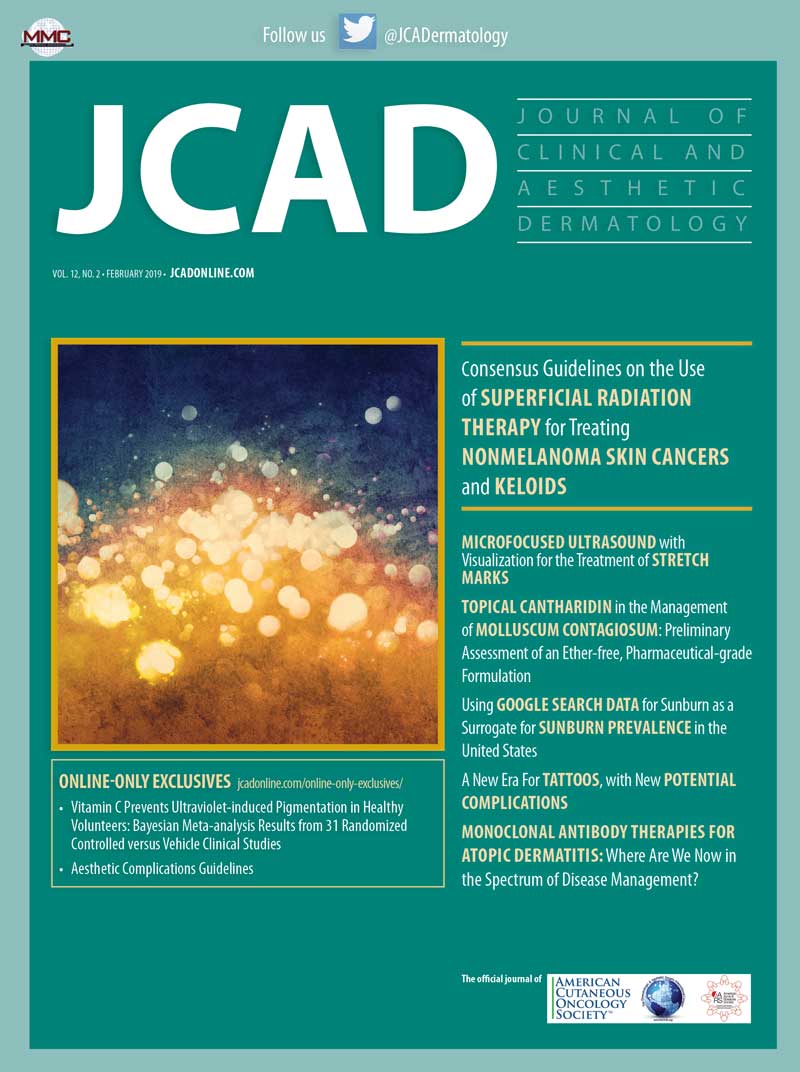 Dear Colleagues:
Dear Colleagues:
Welcome to the February 2019 issue of The Journal of Clinical and Aesthetic Dermatology (JCAD). As you know, JCAD’s mission has always been to provide the latest high-quality clinical information on which you, our readers, rely to continually improve the care of your patients. To help us meet this objective and in response to JCAD’s ever-increasing number of submissions, we’re pleased to introduce the JCAD “Online-only Exclusives” department, which can be accessed via the journal’s website (jcadonline.com); the eEdition, the digital replica of each month’s printed edition (jcad.mydigitalpublication.com); and via the journal’s indexing services (e.g., Pubmed Central). We are offering this online-only option as an alternative to JCAD’s standard all-inclusive publication package. Articles published via the online-only option will be indexed similar to articles published in print. If you have any questions about our Online-only Exclusives publication option, please email the executive editor, Elizabeth Klumpp (eklumpp@matrixmedcom.com).
We start this issue with new consensus guidelines on the use of superficial radiation therapy (SRT) for the treatment of nonmelanoma skin cancers and keloids. In this article, Nestor et al conducted a literature search on the use of SRT, of which the findings were then review by a group of qualified dermatologists. The group then convened to discuss their views and establish consensus guidelines based on a supermajority two-thirds vote. Agreement was reached on numerous aspects of SRT use, including appropriate tumor types; suitable anatomical areas; energy, fractions, and scheduling recommendations; comorbidities; safety factors; and treatment of recurrent keloids.
Next, in the article “Microfocused Ultrasound with Visualization (MFU-V) for the Treatment of Stretch Marks,” Casabona describes results of a follow-up study evaluating the use of MFU-V for improvements in appearance of striae in subjects whose stretch marks had been previously treated with calcium hydroxylapatite (CaHA) filler, topical application of 20% ascorbic acid solution, and microneedling. Efficacy was based on changes in Manchester Scar Scale (MSS) scores, and patient satisfaction was based on changes in Patient Satisfaction Scale scores. At Day 90 post-treatment, the mean baseline MSS score decreased from 9.35 to 6.30 and the mean PSS score increased from 3.75 to 4.70. No adverse events were reported. The author concluded that MFU-V has the potential to further improve the appearance of stretch marks that were previously treated using a combined approach of CaHA, 20% ascorbic acid, and microneedling therapy.
Following this, Del Rosso and Kircik review etiology and treatment options of molluscum contagiosum (MC), focusing primarily on topical cantharidin. Randomized, controlled studies assessing safety and efficacy of topical cantharidin are, to date, limited; however, the authors provide a brief overview of a recent Phase II pilot study showing promising results using a specific formulation of cantharidin 0.7% solution [w/v] (VP-102) for the treatment of MC.
Next, Hopkins et al share the results of their study, “Using Google Search Data for Sunburn as a Surrogate for Sunburn Prevalence in the United States.” Here, investigators assessed state-based Google search volumes for sunburn topics to determine any associations between frequency of searches and environmental risk factors for ultraviolet (UV) exposure. The authors reported that the analyzed data indicate searches for sunburn in the United States are directly correlated with certain UV exposure measures, suggesting that search volume for sunburn could potentially be used as a surrogate marker for state sunburn prevalence.
Following this, in a commentary by Maarouf et al titled “A New Era For Tattoos, with New Potential Complications,” the authors describe the recent popular trend of “animal friendly“ ink-based tattoos. Considering available evidence regarding known adverse effects the topical application of these plant-based pigments can cause, the authors predict the potential adverse reactions these ingredients might have when injected intradermally.
Next, in the first installment of a new bi-monthly column series titled “What’s New in the Medicine Chest?” Del Rosso provides an overview of systemic therapies for atopic dermatitis (AD), including conventional oral options and injectable biologic agents that modulate the immune dysregulation in AD. Major emphasis is placed on the emerging use of monoclonal antibodies.
And don’t miss this month’s online exclusive by de Dormael et al titled, “Vitamin C Prevents Ultraviolet-induced Pigmentation in Healthy Volunteers: Bayesian Meta-analysis Results from 31 Randomized Controlled versus Vehicle Clinical Studies.” Here, investigators reviewed the literature, and, taking dose response and different skin type populations (Caucasian and Chinese) into consideration, assessed whether vitamin C has the potential to limit ultraviolet (UV) daylight-induced pigmentation. According to the reviewed data, the authors report that Vitamin C appears to be effective in reducing daylight-induced pigmentation in a dose-dependent manner. However, vitamin C does not appear to have any other additive value, thus leading the authors to conclude that lightening properties described in the literature might only correspond to an antipigmenting effect, over a depigmenting effect.
And finally, it is with great sadness we announce the loss of one of JCAD’s Editorial Advisory Board members, Vic Narurkar, MD, who passed away unexpectedly last month. Vic was not only a well-respected dermatologist, he was a good friend and will be sorely missed. We invite you to read the eulogy written by Phil Werschler, in which he shares fond memories of Vic as a friend and colleague. The eulogy can be accessed online at jcadonline.com/vic-narurkar-eulogy/ and in the February e-Edition on page E60.
We hope you enjoy this issue of JCAD. As always, we welcome your feedback and submissions.
With regards,
James Q. Del Rosso, DO, FAOCD—Editor-in-Chief, Clinical Dermatology
Wm. Philip Werschler, MD, FAAD, FAACS—Editor-in-Chief, Aesthetic Dermatology
Seemal R. Desai, MD, FAAD— Associate Editor

